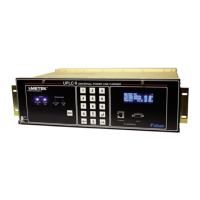Page 3–18
UPLC-II™ System Manual
3.5.2 Permissive Overreaching
Transfer Trip Systems
Overreaching transfer trip systems require a chan-
nel signal to trip, and are used with a frequency-
shift audio tone, modulated on a communication
channel (e.g., public or private telephone lines).
These systems are generally not used with Power-
Line Carriers. There are, however, successful
applications of Power-Line Carrier on POTT
schemes where parallel lines allow for cross-cou-
pling of the carrier signal.
3.5.3 Permissive and Non-Permissive
Underreaching Transfer Trip
Systems
For overreaching systems, the directional phase
and ground trip fault detectors (P) must be set to
overlap within the transmission line and not over-
reach any terminals (see Figure 3–10).
That is, at least one trip fault detector (P) must
operate for all internal faults, and none should
operate for any external fault. In practice, distance
relays are normally required for both ground faults
and phase faults, although directional instanta-
neous ground-overcurrent relays might meet these
requirements in some cases.
Though it is the least complex, the non-permissive
system is rarely used because of the high potential
for false outputs from the channel, which would
cause incorrect tripping. If a non-permissive sys-
tem is used, the channel considerations should be
as described later for direct trip systems. The sys-
tem is made permissive by the additional set of
phase and ground overreaching fault detectors
(FD), which must operate for all internal faults
(see Figure 3–10).
Operation of the underreaching transfer trip
scheme shown in Figure 3–10 is described in
Table 3–5 for external and internal faults.
Because the trip fault detectors (P) do not operate
for external faults, underreaching transfer trip sys-
tems do not require external fault-clearing coordi-
nation circuits (transient blocking) and are, there-
fore, inherently simpler than any of the other
schemes. You obtain maximum security if you use
additional permissive fault detectors. These
schemes also provide minimum operating times
for many faults that are tripped directly, without
using the channel.
3.5.4 Dual Phase Comparison
Unblocking Systems
Dual comparison systems require a duplex chan-
nel: one frequency for each line terminal. The
UPLC-II™ frequency-shift channel equipment is
available for this purpose; normally used in an
unblocking system. Continuous channel monitor-
ing is also provided, because either a trip positive
or trip negative carrier signal is always transmit-
ted.
The transmitter is keyed to its trip positive fre-
quency when the square wave from the filter goes
positive, and is keyed to its trip negative frequen-
cy when the square wave is at zero. There are two
outputs at the receiver: the trip positive output is a
square wave that goes positive when a trip posi-
tive frequency is received; the trip negative output
goes positive when a trip negative frequency is
received.
The basic operation of the Dual Phase
Comparison system is shown in Figure 3–11. For
internal faults, the single phase outputs of the
sequence current networks are essentially in
phase, although such output represents currents
180° apart in the power system. The network out-
put goes through a squaring amplifier that keys the
frequency shift transmitter. An adjustable delay
circuit delays the local square wave by a time
equal to the channel delay time.
The network output is then used to develop two
complementary square waves. One wave, which
has a positive state during the positive half-cycle
of the sequence current network, is compared with

